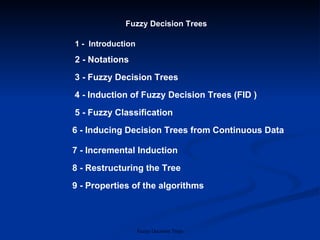
Presentation Fuzzy
- 1. Fuzzy Decision Trees 1 - Introduction 2 - Notations 3 - Fuzzy Decision Trees 4 - Induction of Fuzzy Decision Trees (FID ) 7 - Incremental Induction 8 - Restructuring the Tree 9 - Properties of the algorithms 5 - Fuzzy Classification 6 - Inducing Decision Trees from Continuous Data
- 2. Abstract. We present a new classification algorithm that combines three properties: It generates decision trees , which proved a valuable and intelligible tool for classification and generalization of data; it utilizes fuzzy logic , that provides for a fine grained description of classified items adequate for human reasoning; and it is incremental , allowing rapid alternation of classification and learning of new data. The algorithm generalizes known non–incremental algorithms for top down induction of fuzzy decision trees, as well as known incremental algorithms for induction of decision trees in classical logic. The algorithm is shown to be terminating and to yield results equivalent to the non–incremental version. Keywords: incremental learning, classification, decision trees, fuzzy logic
- 3. Decision trees have proven to be a valuable tool for description, classification and generalization of data. This is related to the compact and intelligible representation of the learned classification function They provide a hierarchical way to represent rules underlying data. In many practical applications, the data used are inherently of imprecise and subjective nature. A popular approach to capture this vagueness of information is the use of fuzzy logic, going back to Zadeh . The basic idea of fuzzy logic is to replace the “crisp” truth values 1 and 0 by a degree of truth in the interval [0,1]. In many respects, one can view classical logic as a special case of fuzzy logic, providing a more fine grained representation for imprecise human judgments.
- 4. To combine the advantages of decision trees and fuzzy logic, the concept of a decision tree has been generalized to fuzzy logic, and there is a number of algorithms creating such trees. While decision trees with continuous attributes can capture more fine grained decisions (e.g. “if the attribute temperature is between 19.3 and 20.7 the state is classified as safe”), exactly this expressiveness can turn into a problem, since the algorithm has to determine the split points itself. Fuzzy logic is able to generalize multi-valued attributes naturally.
- 5. To the best of our knowledge, the present algorithms for induction of fuzzy decision trees are non–incremental. However, in many applications the collection of new data and the application of the learned function is intertwined. For instance in our project “ Intelligent Systems in e-Commerce ” (ISeC) we try to approximate the preferences of the customers using an e-shop online. Each new web page visited by a user is customized to the learned preferences of the user, and each visit of a web page yields new data on the user behavior, which are used to update the preference function memorized for the user. In such an application non–incremental classification algorithms meet their limits, because they have no way to adapt their results to the new data, but rather have to be restarted from scratch. In such an application, incremental algorithms almost always perform better, because they simply adjust their results.
- 6. we are looking for classification algorithms that are (i) based on decision trees, (ii) utilize fuzzy logic, (iii) are incremental. Surprisingly, there are non–incremental algorithms for fuzzy decision trees, and incremental algorithms for decision trees , but we have found no algorithm that satisfies all three properties.
- 7. Notations
- 11. Fuzzy Decision Trees A fuzzy decision tree (see e.g. Fig. 1) is a tree structure where every edge is annotated with a condition, and every leaf is annotated with a fuzzy set over C. we will discuss an example. One should observe that CLASSIFY yields a fuzzy degree of truth as value; if a crisp output value is desired one can apply any of the well–known defuzzification methods , e.g. take the class with the highest truth value.
- 13. Induction of Fuzzy Decision Trees (FID ) Suppose we have a set of training examples L, and we want to construct a fuzzy decision tree classifying those examples. Similarly to ID3, Janikow describes a process of top down induction of the tree . The main idea is to partition a fuzzy set of training examples according to a heuristically chosen condition recursively , until the remaining parts satisfy a pruning criterion, e.g. are either largely of one class, or of negible size. The partitioning is then represented as a tree.
- 14. For generation of fuzzy decision trees ( FID ): we need to specify when to stop the partitioning. This is the task of a pruning criterion . Both the pruning criterion and the heuristic need to be fixed during the lifetime of a tree, so we just mention these as implicit parameters in the algorithms.
- 15. The basic idea behind the partitioning process is to reach partitions in which the vast majority of the examples belongs to only one class, i.e. the partition is “pure”. Thus, if an example of unknown class belongs to such a partition, one can safely assume it is of the class the majority is in. Information content :
- 17. Incremental Induction In a first step, we just adapt the annotations on the tree according to the new examples without changing the structure of the tree, except turning leafs into subtrees when the pruning criterion is no longer met. Thus, the new examples are taken into considerations without computationally expensive recalculations of the tree. So we have to perform a second step once in a while, that corrects these shortcomings and ensures that the test condition at each inner node is the one the used heuristic recommends.
- 24. Properties of the algorithms